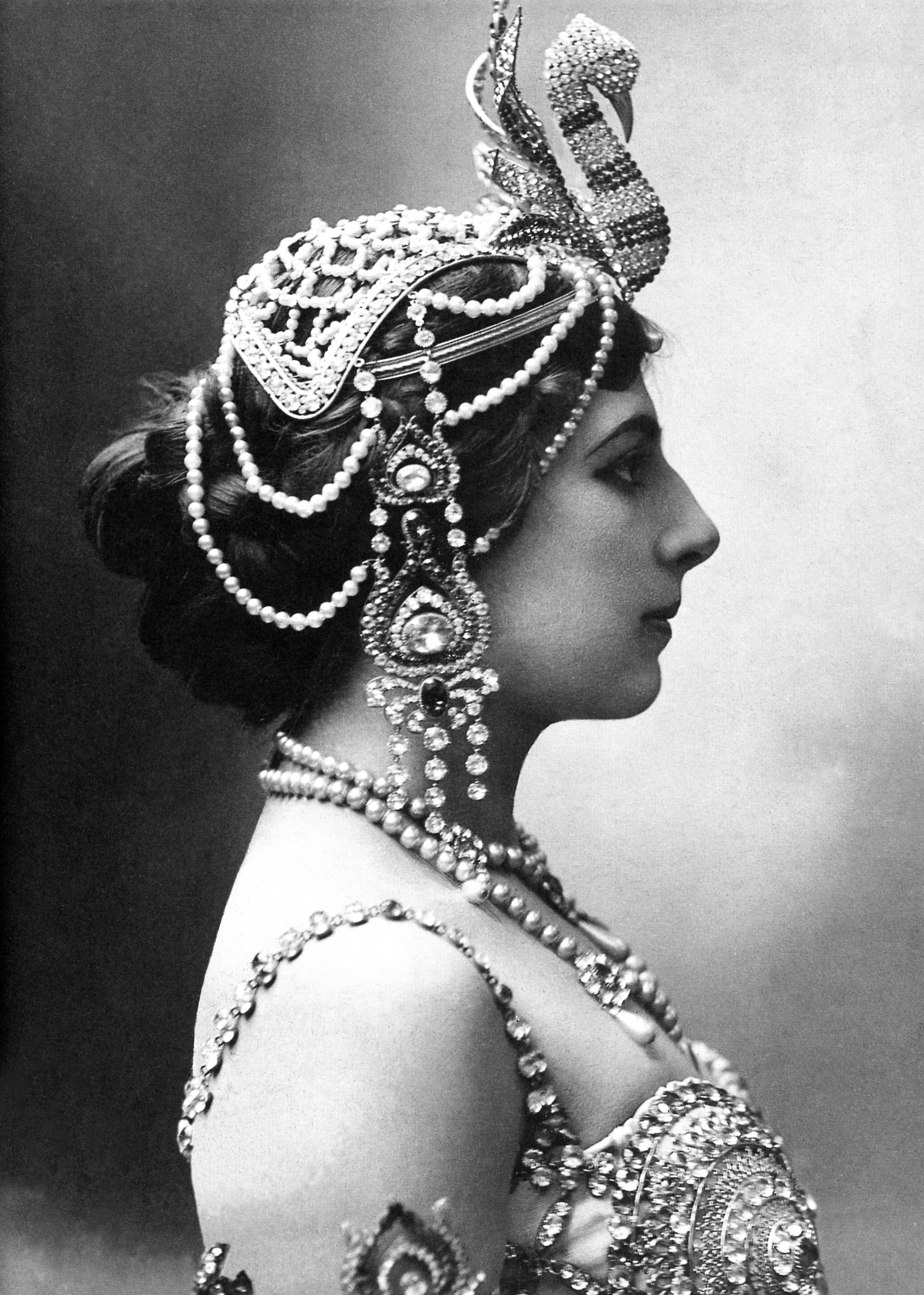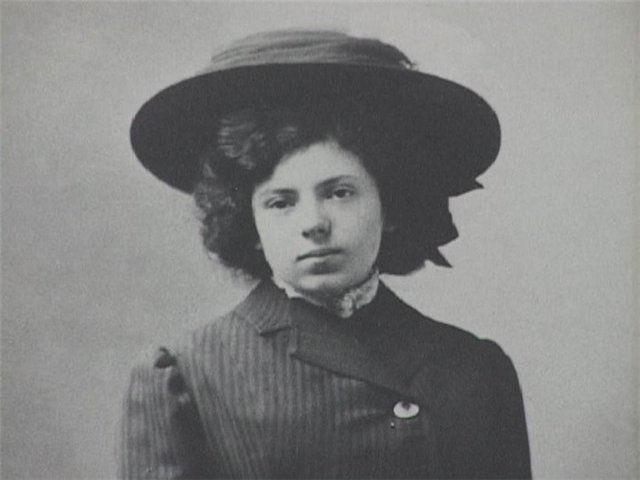She enticed audiences with her dancing, her exoticism and eroticism – and her bejewelled bra, but in 1917, Mata Hari, a Malayan term meaning ‘eye of the day’, was shot by firing squad.
Margaretha Zelle
 Born 7 August 1876 to a wealthy Dutch family, Margaretha Geertruida Zelle responded to a newspaper advertisement from a Rudolf MacLeod, a Dutch army officer of Scottish descent, seeking a wife. The pair married within three months of meeting each other and in 1895 moved to the Dutch East Indies (Indonesia) where they had two children.
Born 7 August 1876 to a wealthy Dutch family, Margaretha Geertruida Zelle responded to a newspaper advertisement from a Rudolf MacLeod, a Dutch army officer of Scottish descent, seeking a wife. The pair married within three months of meeting each other and in 1895 moved to the Dutch East Indies (Indonesia) where they had two children.
The marriage was doomed from the beginning – 22 years older, MacLeod was an abusive husband and Zelle was never going to play the part of the dutiful wife. Their son died aged 2 from syphilis, reputably inherited from his father (their daughter would die a similar death, aged 21) and in 1902, on their return to the Netherlands, they separated.
Unable to find work and uncertain about her future, Zelle moved to Paris and there changed her name to Mata Hari, claiming she originated from India and was the daughter of a temple dancer. She started to earn a living by modelling and dancing, and found work in a cabaret. Exotically dressed, she became a huge success and was feted by the powerful and rich of Paris, taking on a number of influential lovers. She travelled numerous times between France and the Netherlands. But by now war had broken out and Mata Hari’s movements and high-ranking liaisons caused suspicion.
Arrested
Arrested by the British, Hari was interrogated. She admitted to passing German information on to the French. In turn, the French discovered evidence, albeit of doubtful authenticity, that she was spying for the Germans under the codename ‘H21’. Hari had indeed been recruited by the Germans, given the name H21 and received 20,000 francs as a down payment. Never one to turn down money, she accepted it but did no spying in return nor ever felt obliged to.
 Returning to Paris, Hari was then arrested by the French and accused of being a double agent. The evidence against her was virtually non-existent, and the prosecution found not a single item or piece of information passed from Mata Hari to the Germans. The trial itself was of dubious nature as her defence was prohibited from cross-examining witnesses. Her defence lawyer was a 74-year-old man, a former lover, and his association with Hari diminished his authority. The six-man jury had little hesitation in finding Mata Hari guilty.
Returning to Paris, Hari was then arrested by the French and accused of being a double agent. The evidence against her was virtually non-existent, and the prosecution found not a single item or piece of information passed from Mata Hari to the Germans. The trial itself was of dubious nature as her defence was prohibited from cross-examining witnesses. Her defence lawyer was a 74-year-old man, a former lover, and his association with Hari diminished his authority. The six-man jury had little hesitation in finding Mata Hari guilty.
And shot
At dawn on 15 October 1917, Mata Hari, wearing a three-cornered hat, was led out of her cell to face her death. She told an attendant nun, ‘Do not be afraid, sister, I know how to die.’ She refused to be tied to the stake or blindfolded, and waved at onlookers and blew kisses at the priest and her lawyer. She was shot by a 12-man firing squad, each wearing a red fez. The officer in charge ensured she was dead by firing a bullet into her head. She was 41.
Thirty years later, one of the prosecutors admitted that ‘there wasn’t enough evidence [against Mata Hari] to flog a cat.’
 Rupert Colley.
Rupert Colley.
Read more in The Clever Teens’ Guide to World War One, available as ebook and paperback (80 pages) on Amazon, Barnes & Noble, Waterstone’s, Apple Books and other stores.
 In 1907, Hitler moved to Vienna while August Kubizek remained in Linz to work as an apprentice
In 1907, Hitler moved to Vienna while August Kubizek remained in Linz to work as an apprentice 
 Read more about the Cold War in The Clever Teens’ Guide to the Cold War (75 pages) available as paperback and ebook from
Read more about the Cold War in The Clever Teens’ Guide to the Cold War (75 pages) available as paperback and ebook from 
 A fervent supporter of Hitler, 36-year-old Count Claus von Stauffenberg had fought bravely during the Second World War for the Fuhrer. Fighting in Tunisia in 1943, Stauffenberg was badly wounded, losing his left eye, his right hand and two fingers of his left. Once recovered, Stauffenberg was transferred to the Eastern Front where he witnessed the atrocities firsthand which made him question his loyalty. As it became increasingly apparent that Germany would not win the war, Stauffenberg lost faith in Hitler and the Nazi cause.
A fervent supporter of Hitler, 36-year-old Count Claus von Stauffenberg had fought bravely during the Second World War for the Fuhrer. Fighting in Tunisia in 1943, Stauffenberg was badly wounded, losing his left eye, his right hand and two fingers of his left. Once recovered, Stauffenberg was transferred to the Eastern Front where he witnessed the atrocities firsthand which made him question his loyalty. As it became increasingly apparent that Germany would not win the war, Stauffenberg lost faith in Hitler and the Nazi cause. The earlier chapters concern Hitler’s upbringing, his formative years in Linz, Vienna, and Munich, his desire to be an
The earlier chapters concern Hitler’s upbringing, his formative years in Linz, Vienna, and Munich, his desire to be an 
 Born 18 July 1887, Vidkun Quisling’s life and early career had started promisingly. As a child, the son of a Lutheran pastor, he was considered somewhat a mathematical child prodigy and, as a young cadet coming out of military school, he gained the highest recorded marks in Norway.
Born 18 July 1887, Vidkun Quisling’s life and early career had started promisingly. As a child, the son of a Lutheran pastor, he was considered somewhat a mathematical child prodigy and, as a young cadet coming out of military school, he gained the highest recorded marks in Norway. With no support and no influence, Quisling looked destined to wither away into obscurity. But in Adolf Hitler, whom Quisling visited in December 1939, he had a friend.
With no support and no influence, Quisling looked destined to wither away into obscurity. But in Adolf Hitler, whom Quisling visited in December 1939, he had a friend.
 Vera
Vera  Rupert Colley.
Rupert Colley. Much of India, at the time, was governed by the East India Company. The monolithic,
Much of India, at the time, was governed by the East India Company. The monolithic,  The British took refuge on the fort’s ramparts. One soldier escaped, took to his horse and galloped the sixteen miles to the garrison based
The British took refuge on the fort’s ramparts. One soldier escaped, took to his horse and galloped the sixteen miles to the garrison based 